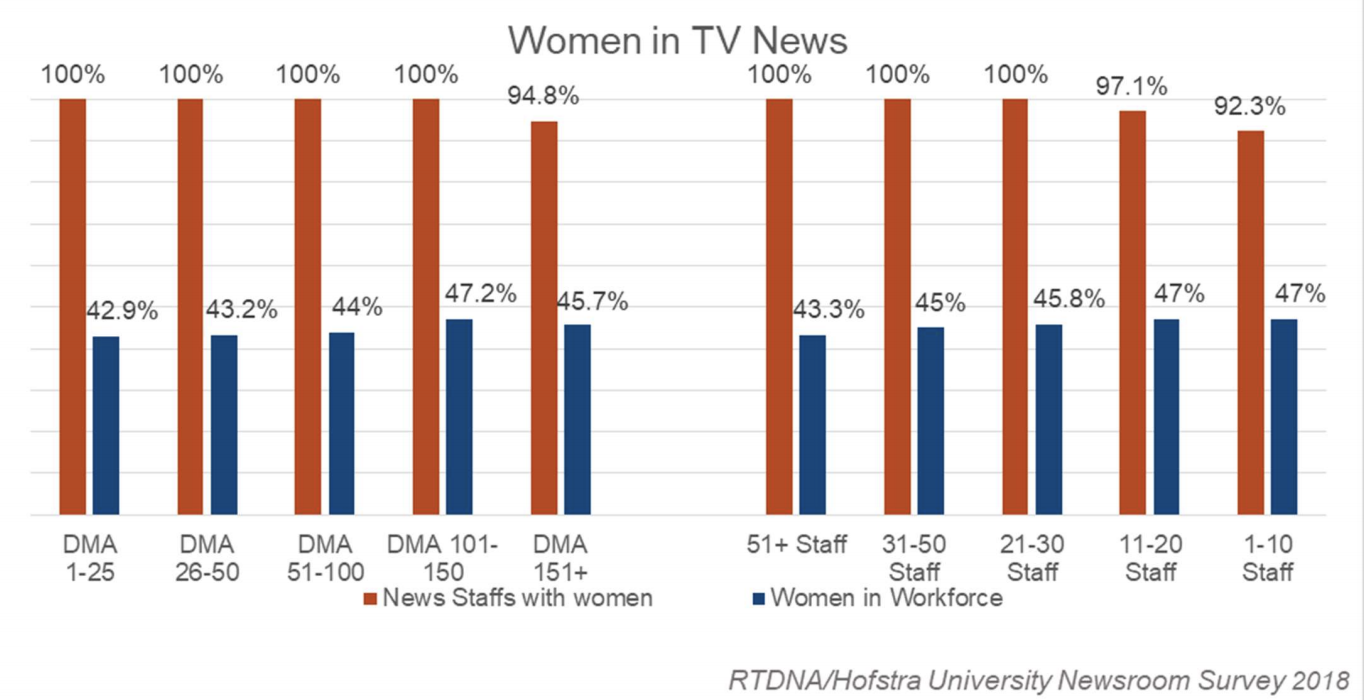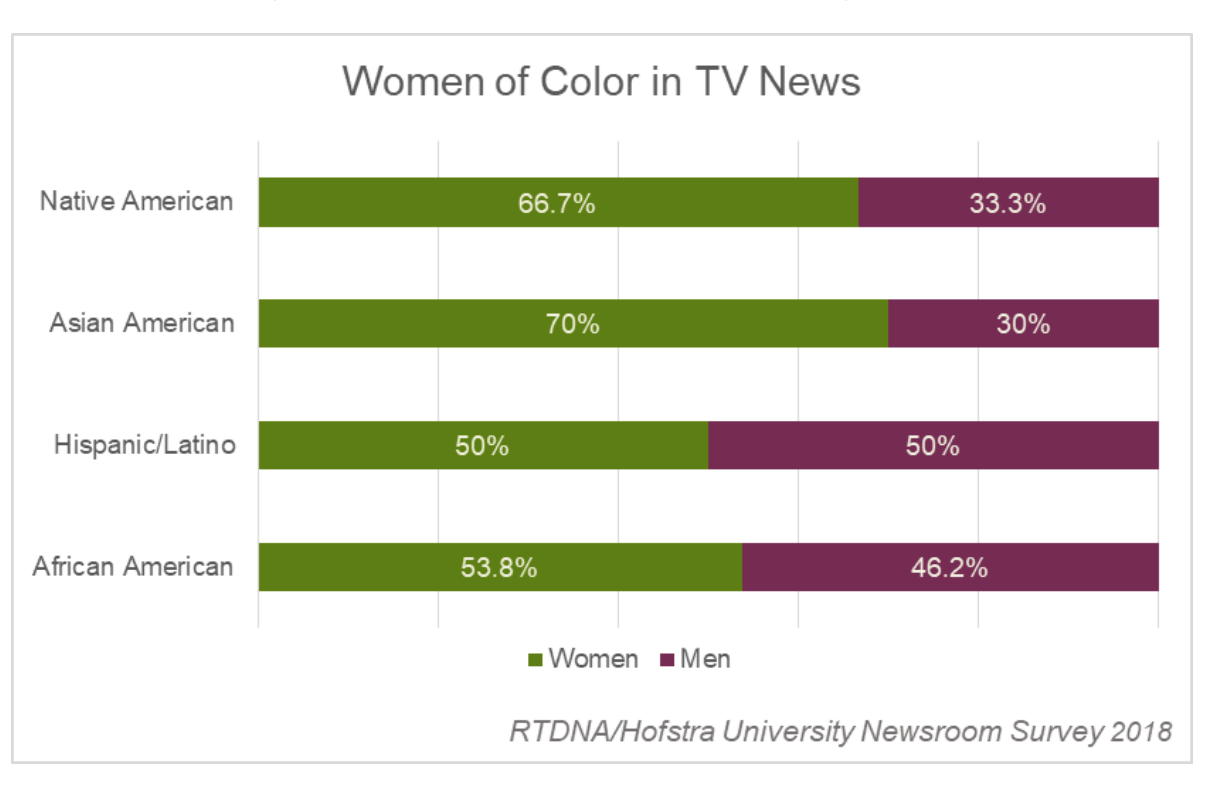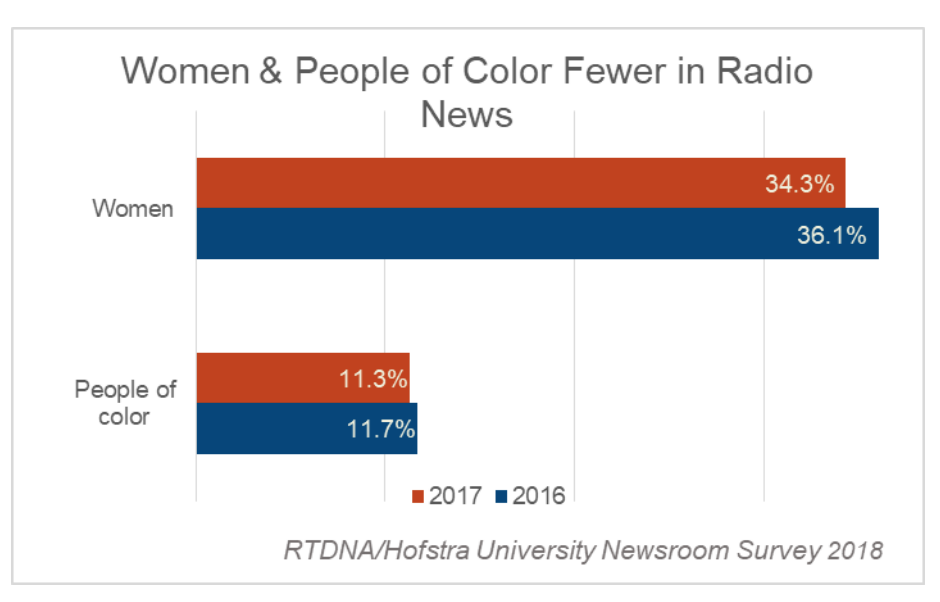
The good news is that women are slowly seeing themselves reflected in a wider variety of broadcast newsroom jobs. The bad news is that people of color are still struggling to reach proportional numbers of representation in newsrooms.
RTDNA and Hofstra surveyed 1,683 non-satellite TV stations and a sample of 3,542 radio stations in the fourth quarter of 2017. 1,333 TV stations responded (79.2 percent of those asked), and 415 radio news directors and general managers representing 1,110 radio stations responded.
More women of color are in TV management than ever before — barely. Beating the record of 24.6 percent in 2001, this year 24.8 percent of respondents in local TV news are people of color. That’s up from 17.8 percent in 1990, but it’s not representative of the general U.S. population, which is 38.3 percent non-white.
Women are better represented in TV and radio newsrooms than in previous years. The percentage of women in the local TV news workforce was 44.4 percent in 2017, up 0.4 percent from 2016. But as markets get larger, the percentage of women in the newsroom gets smaller: Women made up 47.2 percent of TV newsroom staffers in markets 101-150, 44 percent in markets 51-100, and 43.1 percent in the top 50 markets.
“A few stations with newsrooms staffs of up to 20 or in markets 151+ still report no women on the news team.”

More people of color are TV news directors than ever, up about 10 percent since 1990 and up 2.5 percent since 2016. But this hasn’t kept pace with the growth of the non-white population in the U.S.
Regionally, the survey found that “stations in the South and West were far more diverse than stations in the Northeast or, particularly, the Midwest, as has generally been the case in past years.” Also, “Fox affiliates were about 50 percent more diverse than any of the other network affiliates.”
And “among people of color in newsrooms, women of color are now better represented in newsrooms
overall than men of color, particularly among Asian Americans and Native Americans.”

You might expect general managers at Spanish-language stations to be Hispanic, considering that “overall, 93.6 percent of the TV news workforce at Spanish-language stations are Hispanic, up from 87.6 percent in 2016.” But no: “A surprisingly low 63.6 percent of general managers at Spanish language stations are Hispanic, up a point from a year ago. The rest are white.”
“The big picture for people of color in local radio news shows an industry going nowhere.”
Radio station leadership in 2017 included fewer people of color, and fewer women, than in 2016.

Less than half of radio news staffs have even a single woman on the team. The percentage of staffs with any women at all dropped nearly four percent between 2016 and 2017. While more women are becoming station general managers and news directors (up 1.2 percent and 5.3 percent, respectively, over 2016), women are twice as likely to be news directors at non-commercial stations than at commercial ones — though “overall their representation decreased at non-commercial stations, too.” And, overall, the percentage of women working in radio news is slipping: “Women fell from 36.1 percent of the radio news workforce [in 2016] to 34.3 percent” in 2017.
Though women are making up a larger portion of the workforce in some newsrooms, that doesn’t necessarily translate to leadership roles. In major markets (of more than 1 million listeners), women made up 40.7 percent of the newsroom, but only 25.8 percent of news directors.
Radio newsrooms are also doing poorly when it comes to racial diversity. People of color made up 11.3 percent of radio newsroom staffs in 2017, down from 11.7 percent in 2016. “The percentage of staffs with any people of color dropped for both commercial and noncommercial stations. Commercial stations’ number of news directors of color and people of color as a percentage of the work force improved, but non-commercial stations grew less diverse across the board.”
It’s frustrating that newsroom diversity is making little headway year after year, though with more women of color taking up leadership roles, there is the chance that more room will be made at the top. Audiences are growing more diverse for broadcast news, and it’s a business imperative to reflect the customer base.